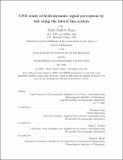| dc.contributor.advisor | Houshuo Jiang. | en_US |
| dc.contributor.author | Rapo, Mark Andrew | en_US |
| dc.contributor.other | Woods Hole Oceanographic Institution. | en_US |
| dc.date.accessioned | 2009-09-24T20:48:48Z | |
| dc.date.available | 2009-09-24T20:48:48Z | |
| dc.date.copyright | 2009 | en_US |
| dc.date.issued | 2009 | en_US |
| dc.identifier.uri | http://hdl.handle.net/1721.1/46805 | |
| dc.description | Thesis (Ph. D.)--Joint Program in Oceanography/Applied Ocean Science and Engineering (Massachusetts Institute of Technology, Dept. of Mechanical Engineering; and the Woods Hole Oceanographic Institution), 2009. | en_US |
| dc.description | This electronic version was submitted by the student author. The certified thesis is available in the Institute Archives and Special Collections. | en_US |
| dc.description | Includes bibliographical references (leaves 264-277). | en_US |
| dc.description.abstract | The lateral line system on fish has been found to aid in schooling behavior, courtship communication, active and passive hydrodynamic imaging, and prey detection. The most widely used artificial prey stimulus has been the vibrating sphere, which some fish are able to detect even when the signal velocities to its lateral line are orders of magnitude smaller than background current velocities. It is not clear how the fish are able to extract this signal. This thesis uses a series of computational fluid dynamic (CFD) simulations, matched with recent experiments, to quantify the effects of 3D fish body parts on the received dipole signals, and to determine signal detection abilities of the lateral line system in background flow conditions. An approximation is developed for the dipole induced, oscillatory, boundary layer velocity profile over the surface of a fish. An analytic solution is developed for the case when the surface is a wall, and is accurate at points of maximal surface tangential velocity. Results indicate that the flow outside a thin viscous layer remains potential in nature, and that body parts, such as fins, do not significantly affect the received dipole signal in still water conditions. In addition, the canal lateral line system of the sculpin is shown to be over 100 times more sensitive than the superficial lateral line system to high frequency dipole stimuli. Analytical models were developed for the Mottled Sculpin canal and superficial neuromast motions, in response to hydrodynamic signals. When the background flow was laminar, the neuromast motions induced by the stimulus signal at threshold had a spectral peak larger than spectral peaks resulting from the background flow induced motions. | en_US |
| dc.description.abstract | (cont.) When the turbulence level increased, the resulting induced neuromast motions had dominant low frequency oscillations. For fish using the signal encoding mechanisms of phase-locking or spike rate increasing, signal masking should occur. | en_US |
| dc.description.statementofresponsibility | by Mark Andrew Rapo. | en_US |
| dc.format.extent | 277 leaves | en_US |
| dc.language.iso | eng | en_US |
| dc.publisher | Massachusetts Institute of Technology | en_US |
| dc.rights | M.I.T. theses are protected by
copyright. They may be viewed from this source for any purpose, but
reproduction or distribution in any format is prohibited without written
permission. See provided URL for inquiries about permission. | en_US |
| dc.rights.uri | http://dspace.mit.edu/handle/1721.1/7582 | en_US |
| dc.subject | /Woods Hole Oceanographic Institution. Joint Program in Oceanography/Applied Ocean Science and Engineering. | en_US |
| dc.subject | Mechanical Engineering. | en_US |
| dc.subject | Woods Hole Oceanographic Institution. | en_US |
| dc.subject.lcsh | Lateral line organs | en_US |
| dc.subject.lcsh | Signal detection | en_US |
| dc.title | CFD study of hydrodynamic signal perception by fish using the lateral line system | en_US |
| dc.title.alternative | Computational fluid dynamic study of hydrodynamic signal perception by fish using the lateral line system | en_US |
| dc.type | Thesis | en_US |
| dc.description.degree | Ph.D. | en_US |
| dc.contributor.department | Joint Program in Oceanography/Applied Ocean Science and Engineering | en_US |
| dc.contributor.department | Woods Hole Oceanographic Institution | en_US |
| dc.contributor.department | Massachusetts Institute of Technology. Department of Mechanical Engineering | |
| dc.identifier.oclc | 429908519 | en_US |
